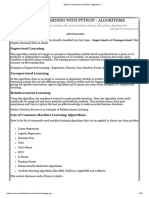Assignment B 1 LinearRegression
Uploaded by
Mahesh KadamAssignment B 1 LinearRegression
Uploaded by
Mahesh KadamB.E.
(COMP) Sinhgad Institute of Technology, Lonavala LP_III
Name of the Student: __________________________________ Roll No: ___
CLASS: - B. E. [COMP] Division: A, B, C Course: LP-III
Machine Learning
Assignment No. 01
UBER RIDE FARE PREDICTION
Marks: /10
Date of Performance: / /2023
2024 Sign with Date:
Title : Uber ride fare prediction using regression algorithms
Objectives:
• To analyse Uber ride dataset to predict the fare of a ride.
• To compare performance of different regressors.
Outcomes:
• Predict the sales of a store.
PEOs, POs, PSOs and COs satisfied
PEOs: I, III POs: 1, 2, 3, 4, 5 PSOs: 1, 2 COs: 1
Problem Statement:
Predict the price of the Uber ride from a given pickup point to the agreed drop-off location.
Perform following tasks:
1. Pre-process the dataset.
2. Identify outliers.
3. Check the correlation.
4. Implement linear regression and random forest regression models.
5. Evaluate the models and compare their respective scores like R2, RMSE, etc.
Dataset link: https://www.kaggle.com/datasets/yasserh/uber-fares-dataset
Theory:
Linear Regression
In statistics, linear regression is a linear approach to modeling the relationship between a
scalar response (or dependent variable) and one or more explanatory variables (or independent
variables). The case of one explanatory variable is called simple linear regression. For more
than one explanatory variable, the process is called multiple linear regression.
Linear Regression Equation:
Linear regression is a way to model the relationship between two variables. You might also
recognize the equation as the slope formula. The equation has the form Y= a + bX, where Y
1 | Department of Computer Engineering, SIT, Lonavala
B.E. (COMP) Sinhgad Institute of Technology, Lonavala LP_III
is the dependent variable (that’s the variable that goes on the Y axis), X is the independent
variable (i.e. it is plotted on the X axis), b is the slope of the line and a is the y-intercept.
Simple Linear Regression
Simple or single-variate linear regression is the simplest case of linear regression with a single
independent variable, 𝐱 = 𝑥.
The following figure illustrates simple linear regression:
Simple Linear Regression With scikit-learn
1. Import the packages and classes you need.
2. Provide data to work with and eventually do appropriate transformations.
3. Create a regression model and fit it with existing data.
4. Check the results of model fitting to know whether the model is satisfactory.
5. Apply the model for predictions.
These steps are more or less general for most of the regression approaches and
implementations.
Linear Regression – Implementation using scikit learn
from sklearn.linear_model import LinearRegression
from sklearn.metrics import mean_squared_error
# Cannot use Rank 1 matrix in scikit learn
X = X.reshape((m, 1))
# Creating Model
reg = LinearRegression()
# Fitting training data
reg = reg.fit(X, Y)
# Y Prediction
Y_pred = reg.predict(X)
# Calculating R2 Score
r2_score = reg.score(X, Y)
print(r2_score)
2 | Department of Computer Engineering, SIT, Lonavala
B.E. (COMP) Sinhgad Institute of Technology, Lonavala LP_III
Decision Tree
Decision tree builds regression or classification models in the form of a tree structure. It breaks
down a dataset into smaller and smaller subsets while at the same time an associated decision
tree is incrementally developed. The final result is a tree with decision nodes and leaf nodes.
A decision node (e.g., Outlook) has two or more branches (e.g., Sunny, Overcast and Rainy),
each representing values for the attribute tested. Leaf node (e.g., Hours Played) represents a
decision on the numerical target. The topmost decision node in a tree which corresponds to the
best predictor called root node. Decision trees can handle both categorical and numerical data.
Decision Tree Regression – Implementation using scikit learn
# import the regressor
from sklearn.tree import DecisionTreeRegressor
# create a regressor object
regressor = DecisionTreeRegressor(random_state = 0)
# fit the regressor with X and Y data
regressor.fit(X, y)
# predicting a new value
# test the output by changing values, like 3750
y_pred = regressor.predict(3750)
# print the predicted price
print("Predicted price: % d\n"% y_pred)
Random Forest Regression
3 | Department of Computer Engineering, SIT, Lonavala
B.E. (COMP) Sinhgad Institute of Technology, Lonavala LP_III
Random Forest Regression is a supervised learning algorithm that uses ensemble
learning method for regression. Ensemble learning method is a technique that combines
predictions from multiple machine learning algorithms to make a more accurate prediction than
a single model.
The diagram above shows the structure of a Random Forest. You can notice that the trees run
in parallel with no interaction amongst them. A Random Forest operates by constructing several
decision trees during training time and outputting the mean of the classes as the prediction of all
the trees.
Random Forest Regression – Implementation using scikit learn
# import the regressor
from sklearn.ensemble import RandomForestRegressor
# create regressor object
regressor = RandomForestRegressor(n_estimators = 100,
random_state = 0)
# fit the regressor with x and y data
regressor.fit(x, y)
# predicting a new value
Y_pred = regressor.predict(np.array([6.5]).reshape(1, 1))
# test the output by changing values
# print the predicted price
Y_pred
4 | Department of Computer Engineering, SIT, Lonavala
B.E. (COMP) Sinhgad Institute of Technology, Lonavala LP_III
Conclusion:
Thus we implemented and compared different regressors using PYTHON scikit-learn
library.
A. Write short answer of following questions :
1. What is linear regression?
2. What is pruning in Decision Tree?
3. What is Ensemble Learning?
4. What is Entropy and Information gain in Decision tree algorithm?
5. What is Random Forest? How does it work?
5 | Department of Computer Engineering, SIT, Lonavala
You might also like
- Machine Learning With Python AlgorithmsNo ratings yetMachine Learning With Python Algorithms28 pages
- Linear Regression in Machine learning - GeeksforGeeksNo ratings yetLinear Regression in Machine learning - GeeksforGeeks25 pages
- Supervised Machine Learning - RegressionNo ratings yetSupervised Machine Learning - Regression34 pages
- 7. Machine Learning - Develop machine learning model - RegressionNo ratings yet7. Machine Learning - Develop machine learning model - Regression36 pages
- Lecture-3---Linear-Regression-imran-20022025-092939amNo ratings yetLecture-3---Linear-Regression-imran-20022025-092939am46 pages
- ML Experiment No 1 Linear Regression AnalysisNo ratings yetML Experiment No 1 Linear Regression Analysis3 pages
- DATA MINING and MACHINE LEARNING. PREDICTIVE TECHNIQUES: ENSEMBLE METHODS, BOOSTING, BAGGING, RANDOM FOREST, DECISION TREES and REGRESSION TREES.: Examples with MATLABFrom EverandDATA MINING and MACHINE LEARNING. PREDICTIVE TECHNIQUES: ENSEMBLE METHODS, BOOSTING, BAGGING, RANDOM FOREST, DECISION TREES and REGRESSION TREES.: Examples with MATLABNo ratings yet
- What Is Cardiac Axis ECG Interpretation Geeky MedicsNo ratings yetWhat Is Cardiac Axis ECG Interpretation Geeky Medics1 page
- Warsash New Training Requirements Under Stcw10No ratings yetWarsash New Training Requirements Under Stcw106 pages
- 上海外语口译证书培训与考试系列丛书·英语中级口译证书考试中级口译教程 (第四版) (梅德明) (Z-Library) -1No ratings yet上海外语口译证书培训与考试系列丛书·英语中级口译证书考试中级口译教程 (第四版) (梅德明) (Z-Library) -1697 pages
- Rmo 12 2013 List of Unused Expired Orssiscis Annex D Docxdocx PDF Free100% (2)Rmo 12 2013 List of Unused Expired Orssiscis Annex D Docxdocx PDF Free2 pages
- Ball Valve Data Sheet: Item Requirement NotesNo ratings yetBall Valve Data Sheet: Item Requirement Notes1 page
- Almeida Theatre Production of Homecoming by PinterNo ratings yetAlmeida Theatre Production of Homecoming by Pinter34 pages
- (Extended) Roll Me A Deity - by Assassin NPCNo ratings yet(Extended) Roll Me A Deity - by Assassin NPC35 pages
- Automatic Transmission / Trans: - Automatic Transaxle Assy (U250E)No ratings yetAutomatic Transmission / Trans: - Automatic Transaxle Assy (U250E)2 pages
- Pololu 3pi Robot User's Guide © 2001-2011 Pololu CorporationNo ratings yetPololu 3pi Robot User's Guide © 2001-2011 Pololu Corporation68 pages
- Instant ebooks textbook Foundations of Dynamic Economic Analysis Optimal Control Theory and Applications 1st Edition Michael R. Caputo download all chapters100% (22)Instant ebooks textbook Foundations of Dynamic Economic Analysis Optimal Control Theory and Applications 1st Edition Michael R. Caputo download all chapters85 pages
- Specialist Gynaecologist Hamilton Waikato NZ 3204No ratings yetSpecialist Gynaecologist Hamilton Waikato NZ 32043 pages
- Linear Regression in Machine learning - GeeksforGeeksLinear Regression in Machine learning - GeeksforGeeks
- 7. Machine Learning - Develop machine learning model - Regression7. Machine Learning - Develop machine learning model - Regression
- Lecture-3---Linear-Regression-imran-20022025-092939amLecture-3---Linear-Regression-imran-20022025-092939am
- DATA MINING and MACHINE LEARNING. PREDICTIVE TECHNIQUES: ENSEMBLE METHODS, BOOSTING, BAGGING, RANDOM FOREST, DECISION TREES and REGRESSION TREES.: Examples with MATLABFrom EverandDATA MINING and MACHINE LEARNING. PREDICTIVE TECHNIQUES: ENSEMBLE METHODS, BOOSTING, BAGGING, RANDOM FOREST, DECISION TREES and REGRESSION TREES.: Examples with MATLAB
- What Is Cardiac Axis ECG Interpretation Geeky MedicsWhat Is Cardiac Axis ECG Interpretation Geeky Medics
- 上海外语口译证书培训与考试系列丛书·英语中级口译证书考试中级口译教程 (第四版) (梅德明) (Z-Library) -1上海外语口译证书培训与考试系列丛书·英语中级口译证书考试中级口译教程 (第四版) (梅德明) (Z-Library) -1
- Rmo 12 2013 List of Unused Expired Orssiscis Annex D Docxdocx PDF FreeRmo 12 2013 List of Unused Expired Orssiscis Annex D Docxdocx PDF Free
- Almeida Theatre Production of Homecoming by PinterAlmeida Theatre Production of Homecoming by Pinter
- Automatic Transmission / Trans: - Automatic Transaxle Assy (U250E)Automatic Transmission / Trans: - Automatic Transaxle Assy (U250E)
- Pololu 3pi Robot User's Guide © 2001-2011 Pololu CorporationPololu 3pi Robot User's Guide © 2001-2011 Pololu Corporation
- Instant ebooks textbook Foundations of Dynamic Economic Analysis Optimal Control Theory and Applications 1st Edition Michael R. Caputo download all chaptersInstant ebooks textbook Foundations of Dynamic Economic Analysis Optimal Control Theory and Applications 1st Edition Michael R. Caputo download all chapters
























































































